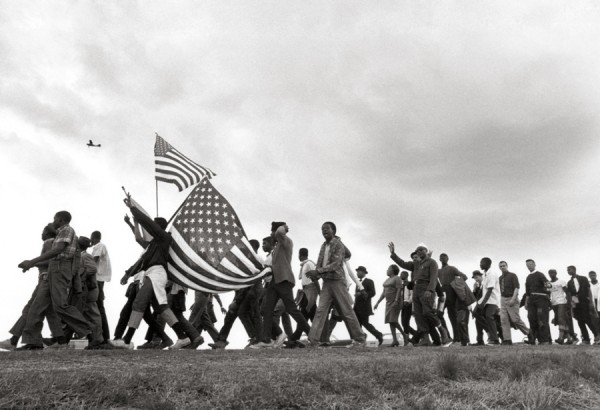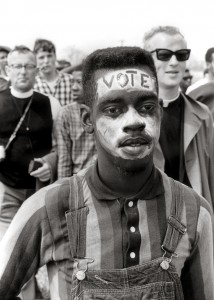2018 School Spending Survey Report
"Selma": Accurate Enough? Questions about the film’s historical accuracy present a teachable moment.
Weighing in on the recent controversy over "Selma" and the ensuing Oscar fallout, author Elizabeth Partridge offers some ideas for engaging students in a discussion about historical accuracy, primary sources, and expert opinion.

Freedom Marchers with Flags, 1965. Photo by Matt Heron
Film director Ava DuVernay kicked a sacred cow in the movie "Selma" with her portrayal of Martin Luther King, Jr. as the tough, demanding driver of the Voting Rights Act of 1965. Influential, well-connected people from Joseph Califano to Maureen Dowd have expressed their dismay at seeing President Lyndon Johnson depicted as the reluctant, recalcitrant president who had his arm twisted into compliance. Others have rushed to DuVernay's defense. The dialog between the two men is discomforting. In real life, King had the finesse of a black preacher born in the segregated South speaking to a white man. He was nuanced and respectful of the President: if not of the man, of the office. But no matter how you parse it, King and Johnson both wanted and needed the Voting Rights Act, and in their own way, worked together to achieve it. The whole controversy misses one of the most skillfully-done aspects of Selma. This is the 1965 voting rights marches seen through the eyes of 2014, the eyes of “Hands up, don’t shoot,” and “Black Lives Matter.” Right now, frustration and anger have a place at the rainbow table we insist is set equally for all Americans. Duvernay masterfully slips in 2014 reference points. Look at the protesters sitting in front of the Dallas County courthouse, fingers laced behind their heads, elbows jutting out. In 1965, people daisy-chained themselves together, crossing one arm over the other to hold hands with those on either side. “Hands up” would have been jarring. Those jutting elbows sneak up on you later, when you Google “Selma” and look at 50 year old black-and-white photographs. Or listen carefully to “Glory,” Common and John Legend’s Golden Globe-winning song: it begins as a swooping spiritual-turned-protest song, moves into rap, bringing us up to 2014 with the lyrics, before slipping back to protest song.
Bobby Simmons, 17 Years Old, Marches for the Vote, 1965. Photo by Matt Herron www.takestockphotos.com
The lyrics remind us that the rainbow promise hasn’t been delivered on: “That’s why Rosa sat on the bus/That’s why we walk through Ferguson with our hands up.” And the path forward: “It takes the wisdom of the elders and young people’s energy.” In the first heady moments of the film’s release, it looked like there might be a place at the table in Hollywood for Duvernay. Though the film has been nominated for an Oscar for Best Picture and Best Original Song, DuVernay was not nominated for Best Director. Hollywood is not ready for the edge in her voice, not ready for her insistence that we open our eyes and place our history in context. Interviewed on NPR's Fresh Air, DuVernay put it this way: "I'm just inviting people into this time and space—into the spirit of Selma in 1965—what it was, what it means now..." This film gives us the opportunity to work with students on historical accuracy, using primary sources and expert opinion. Here are a few good starting points. Have students locate primary source material on President Johnson and Martin Luther King, Jr.- Martin Luther King, Jr.: Cornell University Library has compiled a terrific list of primary sources on King, as has The King Center.
- Lyndon Baines Johnson: the LBJ Library has compiled archival materials (videos, phone calls, historians debating) on the relationship between King and Johnson, and a long list of journal articles with opinions on the film. Full video and transcript of the "American Promise" speech by LBJ. All presidential photos on the site are in the public domain and can be freely copied and used.
- Read the article that appeared in the 1965 New Yorker, Letter from Selma, written by reporter Renata Adler. What do you learn about the young adults who marched that wasn't covered in the film?
- Have students locate archival photos of the Selma protests. Compare them with stills from the film. How are they the same? How are they different?
- Check out the cover of the New Yorker, January 26, 2015. Who are the people portrayed on the cover? What point is the artist trying to make?
Discussion:
Although Selma is not a documentary film, it is a film about real people, in a real historical period. What is the difference between a documentary film and a dramatization? What responsibility does the director, Ava DuVernay, have to historical accuracy? Elizabeth Partridge is the author of Marching For Freedom: Walk Together Children and Don't You Get Weary (Viking Children's Books, 2009).
RELATED
RECOMMENDED
CAREERS
The job outlook in 2030: Librarians will be in demand
CAREERS
The job outlook in 2030: Librarians will be in demand
ALREADY A SUBSCRIBER? LOG IN
We are currently offering this content for free. Sign up now to activate your personal profile, where you can save articles for future viewing






Add Comment :-
Comment Policy:
Comment should not be empty !!!
Elizabeth Partridge`
Leda, These are truly beautiful photographs, and a wonderful primary historical document. This photograph by Morton Broffman http://www.gettyimages.com/detail/news-photo/gathering-at-the-alabama-state-capitol-in-montgomery-to-news-photo/529424993 illustrates one of the points of historical accuracy I was fascinated by. Look at the hands. Where are they? How do people hold their hands during a protest in the movie "Selma"? Why do you think the director made this choice? Do you think this was a good decision by the director Ava DuVernay?Posted : Feb 09, 2015 10:44
leda
Betsy has asked me to link to some photos of the Selma march taken by my beloved uncle, Morton Broffman, a professional photographer who often photographed Martin Luther King and others. You can see 50 of them here: http://www.gettyimages.com/asset-detail/gallery/event/531132603 and some here: http://mortonbroffman.com/mainpages/civilrights.htm My uncle died too young of ALS in 1992. One is mislabeled, probably by Getty. Near the end, James Farmer is actually James Forman.Posted : Feb 09, 2015 02:43
Ed Sullivan
After having students look at the momentous events of 50 years ago, have them examine some troubling recent history. What is noticeably absent in these discussions of the film Selma and Voting Rights Act of 1965 is the tragic gutting of that legislation by the United States Supreme Court a little over two years ago in a 5-4 decision. That decision was and is a spit on the grave of all the brave souls murdered in the cause of Civil Rights, a spit in the face of every person beaten and jailed in the marches and protests. One of those five members of the Supreme Court who voted to gut the Voting Rights Acts is an African American, Clarence Thomas, the inexplicable choice to succeed the great Thurgood Marshall. The five men responsible for this travesty have minds rooted in a profound ignorance of reality, an absurd assumption that the United States have advanced beyond the need for such laws. That's recent history students need to know and discuss.Posted : Jan 30, 2015 01:56